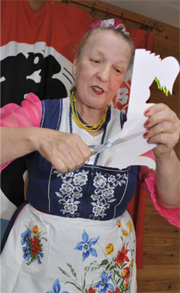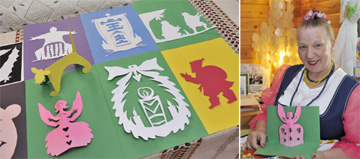Home > Highlighting JAPAN > Highlighting Japan OCTOBER 2012 > Scissors and Silhouettes
Highlighting JAPAN
[SERIES] MASTERS
Scissors and Silhouettes
Elizabeta Suzuki came to Japan in 1972 to marry a Japanese man. Enchanted by the paper-cutting art she began in Japan, she honed her skills under her master, became one of the art's unique exponents, and now performs to rapt audiences from around the world. Toshio Matsubara interviewed the artist.

Elizabeta Suzuki at work on a kamikiri creation
Credit: YOSHIFUSA HASHIZUME
"Kamikiri is a one-chance combination of skill and ideas. The result is different every time," Suzuki says. "I think that's the greatest pleasure of this art."
Switzerland also has a culture of cutting artistic shapes out of paper using a cutter, and Suzuki had always loved working with paper as a form of expression. Origami was the first target of her interest after coming to Japan, and she studied it for three years. She then immersed herself in chigiri-e, in which torn bits of moistened washi (Japanese paper) are used to shape forms with the help of glue and a toothpick. For this, she took lessons for five years.
Then she fell in love with kamikiri. She sought lessons from a master kamikiri performer, Imamaru Hayashiya, who was a friend of her husband. The master told her: "This skill isn't something you can acquire with money. So I'll teach it for free. But you have to promise that you'll do it for life."
In return for the master teaching her kamikiri, Suzuki taught him Italian and English, since he often performs overseas.

Cut paper artworks by Elizabeta Suzuki
Credit: YOSHIFUSA HASHIZUME
In the beginning, Suzuki accompanied her master on stage. Soon she developed her own unique style of performance, wearing traditional Swiss outfits and moving to music while cutting the paper.
"I still get nervous before performances," Suzuki says. "That's when I tell myself, 'I love my audience! I'm going to have fun with them.' Then I'm okay. The real excitement of kamikiri is all about the audience having fun."
Suzuki performs at events such as parties at embassies, expatriate wives' gatherings, reception parties of international businesses and weddings. She has also performed overseas on many occasions. She is fluent in five languages —German, Italian, English, French and Japanese—and this is another skill that supports her efforts to perform kamikiri for audiences of different nationalities. People overseas are consistently amazed at her art, and never fail to give her huge rounds of cheerful applause.
"I'm living this very moment. That's why I don't think about tomorrow or yesterday. I live today, which is filled with dreams," she says. Elizabeta Suzuki's kamikiri performance was indeed true to her words—happy and filled with dreams.
© 2009 Cabinet Office, Government of Japan






